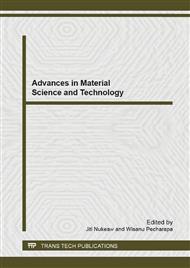[1]
J. Park, D. Lee, E. Yoo, S. Im, Biodegradable polymer blends of Poly(lactic acid) and Starch, Korea polym. J. 7 (1999) 93-101.
Google Scholar
[2]
C. Jun, Reactive blending of biodegradable polymers: PLA and starch, J. Polym. Environ. 8 (2000) 33-37.
Google Scholar
[3]
T. Ke, X. Sun, Starch, poly(lactic acid), and poly(vinyl alcohol) blends, J.Polym. Environ. 11 (2003) 7-14.
Google Scholar
[4]
J. Zhang, X. Sun, Mechanical and thermal properties of poly(lactic acid)/starch blends with dioctyl Maleate, J. Appl. Polym. Sci., 94 (2004) 1697–1704.
DOI: 10.1002/app.21078
Google Scholar
[5]
O. Martin, L. Avérous, Poly(lactic acid): plasticization and properties of biodegradable multiphase systems, Polymer 42 (2001) 6209-6219.
DOI: 10.1016/s0032-3861(01)00086-6
Google Scholar
[6]
Y. Hu, Y.S. Hu, V. Topolkaraev, A. Hiltner, E. Baer, Aging of poly(lactide)/poly(ethylene glycol) blends. Part 2. Poly(lactide) with high stereoregularity, Polymer 44 (2003) 5711-5720.
DOI: 10.1016/s0032-3861(03)00615-3
Google Scholar
[7]
W.C. Lai, W.B. Liau, T.T. Lin, The Effect of end groups of PEG on the crystallization behaviors of binary crystalline blends PEG/PLLA, Polymer 45 (2004) 3073-3080.
DOI: 10.1016/j.polymer.2004.03.003
Google Scholar
[8]
Z. Kulinski, E. Piorkowska, Crystallization, structure and properties of plasticized poly(L-lactide), Polymer 46 (2005) 10290-10300.
DOI: 10.1016/j.polymer.2005.07.101
Google Scholar
[9]
E. Piorkowska, Z. Kulinski, A. Galeski and R. Masirek, Plasticization of semicrystalline poly(L-lactide) with poly(propylene glycol), Polymer 47 (2006) 7178-7188.
DOI: 10.1016/j.polymer.2006.03.115
Google Scholar
[10]
Z. Kulinsku, E. Piorkowska, K. Gadzinowska, M. Stasiak, Plasticization of poly(l-lactide) with poly(propylene glycol), Biomacromolecules 7 (2006) 2128-2135.
DOI: 10.1021/bm060089m
Google Scholar
[11]
I. Pillin, N. Montrelay, Y. Grohens, Thermo-mechanical characterization of plasticized PLA: Is the miscibility the only significant factor, Polymer 47 (2006) 4676-4682.
DOI: 10.1016/j.polymer.2006.04.013
Google Scholar
[12]
H. Li, A. Huneault, Effect of nucleation and plasticization on the crystallization of poly(lactic acid), Polymer 48 (2007) 6855-6866.
DOI: 10.1016/j.polymer.2007.09.020
Google Scholar
[13]
M. Murariu, A.D.S. Ferreira, M. Pluta, L. Bonnaud, M. Alexandre, P. Dubois, Polylactide (PLA)-CaSO4 composites toughened with low molecular weight and polymeric ester-like plasticizers and related performances, Euro. Polym. J. 44 (2008) 3842-3852.
DOI: 10.1016/j.eurpolymj.2008.07.055
Google Scholar
[14]
R. Jaratrotkamjorn, C. Khaokong, V. Tanrattanakul, Toughness enhancement of poly(lactic acid) by blending with natural rubber, J. App. Polym. Sci. 124 (2012) 5027-5036.
DOI: 10.1002/app.35617
Google Scholar
[15]
W. Chumeka, V. Tanrattanakul, J.F. Pilard, P. Pasetto, Effect of poly(vinyl acetate) on mechanical properties and characterisitcs of poly(lactic acid)/natural rubber blends, J. Polym. Environ.
DOI: 10.1007/s10924-012-0531-5
Google Scholar


